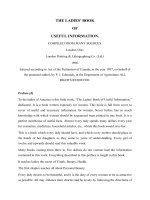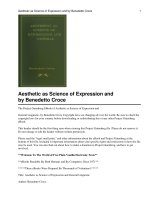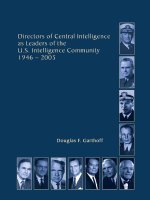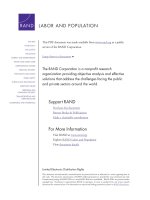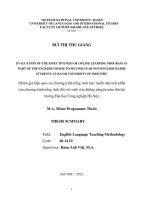Entangled many body states as resources of quantum information processing
Bạn đang xem bản rút gọn của tài liệu. Xem và tải ngay bản đầy đủ của tài liệu tại đây (4.22 MB, 173 trang )
ENTANGLED MANY-BODY STATES
AS RESOURCES OF
QUANTUM INFORMATION
PROCESSING
LI YING
A thesis submitted for the
Degree of Doctor of Philosophy
CENTRE FOR QUANTUM TECHNOLOGIES
NATIONAL UNIVERSITY OF SINGAPORE
2013
DECLARATION
I hereby declare that the thesis is my original work
and it has been written by me in its entirety. I have
duly acknowledged all the sources of information
which have been used in the thesis.
This thesis has also not been submitted for any
degree in any university previously.
LI YING
23 July 2013
Acknowledgments
I am very grateful to have spent about four years at CQT working with
Leong Chuan Kwek. He always brings me new ideas in science and has
helped me to establish good collaborative relationships with other scien-
tists. Kwek helped me a lot in my life. I am also very grateful to Simon
C. Benjamin. He showd me how to do high quality researches in physics.
Simon also helped me to improve my writing and presentation. I hope to
have fruitful collaborations in the near future with Kwek and Simon.
For my project about the ground-code MBQC (Chapter 2), I am thank-
ful to Tzu-Chieh Wei, Daniel E. Browne and Robert Raussendorf. In one
afternoon, Tzu-Chieh showed me the idea of his recent paper in this topic
in the quantum cafe, which encouraged me to think about the ground-
code MBQC. Dan and Robert have a high level of comprehension on the
subject of the MBQC. And we had some very interesting discussions and
communications.
I am grateful to Sean D. Barrett, Thomas M. Stace for their work on my
projects of the distributed QIP (Chapter 3 and Chapter 5). Tom showed me
how to do error corrections on the surface code when he was visiting CQT.
It is a very helpful discussion, and I am still benefiting from that discussion
recently. Sean generously shared his code of simulating the surface code
error correction with me. It is a very powerful code. I have used his code
in my previous three projections (Chapter 4, Chapter 5 and Chapter 6).
I am especially grateful to Leandro Aolita for his great and hard work on
my projects on the subject of quantum optics (Chapter 7 and Chapter 8).
In my first project in CQT (Chapter 7), we began to work together. After
that, we have been in communication and exchange ideas, but somehow we
did not have further collaborations until the last year of my Ph.D., when
i
we have a chance to work together on two more very interesting projects,
in which one is presented in this thesis (Chapter 8), while the other, an
experimental project is still in progress. I enjoyed working together with
Leandro. And I hope that we can have more future collaborations.
For my project about the quantum network (Chapter 6), I am grate-
ful to Daniel Cavalcanti. I am also grateful to Alexia Aufféves, Daniel
Valente and Marcelo Franca Santos for their work on my projects about
one-dimensional atoms, which are not presented in this thesis. I would like
to thank Professor Kerson Huang. We had some very funny discussions at
the beginning of my Ph.D., and I appreciate his sharpness. He has made
physics more interesting for me.
I give special thanks to Professor Zhi Song. He hosted my visiting in
Nankai university. I thank Hu Wenhui and Jin Liang, who helped me a lot
during my visiting in Nankai.
During my Ph.D., I received help from many people in CQT. I would
like to thank Tan Hui Min Evon and Lim Jeanbean Ethan. I also have to
thank people who clean the quantum cafe and my office.
Finally, I would like to thank my parents and especially my wife,
Mingxia, for her unconditional help and sacrifice during my graduate stud-
ies. I must thank my daughter, Daiyao, who is born on the second year of
my Ph.D. She brings me a lot of good luck.
ii
Contents
Acknowledgments i
Table of Contents iii
Summary vii
List of Publications ix
1 Introduction 1
2 Thermal States as Universal Resources for Quantum Com-
putation with Always-on Interactions 7
2.1 Introduction . . . . . . . . . . . . . . . . . . . . . . . . . . . 7
2.2 Cluster states . . . . . . . . . . . . . . . . . . . . . . . . . . 9
2.3 Topological fault-tolerance quantum computation . . . . . . 11
2.4 Measurement-based quantum computing . . . . . . . . . . . 15
2.5 2D System . . . . . . . . . . . . . . . . . . . . . . . . . . . . 16
2.5.1 Ground state and energy gap . . . . . . . . . . . . . 18
2.5.2 POVM and GHZ state . . . . . . . . . . . . . . . . . 18
2.5.3 Cluster state and universality of the ground state . . 19
2.6 3D system and topologically protected cluster state . . . . . 20
2.7 Thermal computational errors and error correction . . . . . 22
2.7.1 Errors on GHZ states . . . . . . . . . . . . . . . . . . 23
2.7.2 Measurements on bond particles . . . . . . . . . . . . 26
2.7.3 Erroneous operators on the cluster state . . . . . . . 27
2.7.4 Error correction . . . . . . . . . . . . . . . . . . . . . 28
2.8 MBQC with always-on interactions . . . . . . . . . . . . . . 30
iii
Contents
3 Fully fault tolerant quantum computation with non-
deterministic gates 33
3.1 Introduction . . . . . . . . . . . . . . . . . . . . . . . . . . . 33
3.2 Non-deterministic entangling operations . . . . . . . . . . . 38
3.3 Growth of cluster states . . . . . . . . . . . . . . . . . . . . 42
3.4 Error model . . . . . . . . . . . . . . . . . . . . . . . . . . . 49
3.5 Error propagation . . . . . . . . . . . . . . . . . . . . . . . . 50
3.6 Error accumulation . . . . . . . . . . . . . . . . . . . . . . . 51
3.7 Final errors on the topologically protected cluster state . . . 53
3.8 Error correction . . . . . . . . . . . . . . . . . . . . . . . . . 55
3.9 Phase diagrams of error correction . . . . . . . . . . . . . . . 57
4 High threshold distributed quantum computing with three-
qubit nodes 61
4.1 Introduction . . . . . . . . . . . . . . . . . . . . . . . . . . . 61
4.2 The states of the art . . . . . . . . . . . . . . . . . . . . . . 63
4.3 A review of broker schemes - remote entangling operations
on client qubits . . . . . . . . . . . . . . . . . . . . . . . . . 65
4.3.1 Effective control-phase gates . . . . . . . . . . . . . . 67
4.3.2 Effective parity projections . . . . . . . . . . . . . . . 68
4.4 Overview of full noise purification with DQC-3 . . . . . . . . 69
4.5 Purifying the parity projection operation . . . . . . . . . . . 70
4.6 Building the TPC state within the constraints of DQC-3 . . 74
4.7 Results . . . . . . . . . . . . . . . . . . . . . . . . . . . . . . 76
5 Long range failure-tolerant entanglement distribution 79
5.1 Introduction . . . . . . . . . . . . . . . . . . . . . . . . . . . 79
5.2 The scheme . . . . . . . . . . . . . . . . . . . . . . . . . . . 81
iv
Contents
5.3 Cluster state growth . . . . . . . . . . . . . . . . . . . . . . 84
5.4 Noise, Imperfections and Error Correction . . . . . . . . . . 90
5.5 Performance . . . . . . . . . . . . . . . . . . . . . . . . . . . 94
6 Two dimensional scalable quantum network with general
noise 97
6.1 Introduction . . . . . . . . . . . . . . . . . . . . . . . . . . . 97
6.2 Scheme . . . . . . . . . . . . . . . . . . . . . . . . . . . . . . 98
6.3 Error thresholds . . . . . . . . . . . . . . . . . . . . . . . . . 104
6.4 Final remote entangled state . . . . . . . . . . . . . . . . . . 105
6.5 Efficiency . . . . . . . . . . . . . . . . . . . . . . . . . . . . 107
7 Photonic multiqubit entangled states from a single atom 109
7.1 Introduction . . . . . . . . . . . . . . . . . . . . . . . . . . . 109
7.2 The protocol . . . . . . . . . . . . . . . . . . . . . . . . . . . 111
7.2.1 GHZ and linear cluster states . . . . . . . . . . . . . 113
7.3 Implementation with
40
Ca . . . . . . . . . . . . . . . . . . . 114
7.4 Implementation with
87
Rb . . . . . . . . . . . . . . . . . . . 116
7.5 Technical details . . . . . . . . . . . . . . . . . . . . . . . . 119
7.6 Feasibility . . . . . . . . . . . . . . . . . . . . . . . . . . . . 121
7.7 Efficiencies and fidelities . . . . . . . . . . . . . . . . . . . . 122
8 Robust-fidelity atom-photon entangling gates in the weak-
coupling regime 125
8.1 Introduction . . . . . . . . . . . . . . . . . . . . . . . . . . . 125
8.2 Photons scattering off two-level emitters in 1D . . . . . . . . 128
8.3 High-fidelity interaction from imperfect processes . . . . . . 131
8.4 Entangling gate for time-bin flying qubits . . . . . . . . . . . 132
8.5 Entangling gate for polarization flying qubits . . . . . . . . . 133
v
Contents
8.6 Single-emitter quantum memories and sequential
measurement-based quantum computations . . . . . . . . . . 135
8.7 Feasibility . . . . . . . . . . . . . . . . . . . . . . . . . . . . 136
8.8 Heralded losses versus infidelities . . . . . . . . . . . . . . . 137
9 Conclusions and Outlook 139
Bibliography 145
vi
Summary
In this thesis we theoretically discuss some proposals of quantum infor-
mation processing without precise manipulations of interactions over a
large number of qubits. Firstly, we study the measurement-based quan-
tum computation utilizing single-particle operations on the thermal state
of a model spin Hamiltonian with always-on interactions. We find com-
putational errors induced by thermal fluctuations can be corrected and
thus the computation can be executed fault tolerantly if the temperature
is below a threshold value. Next, the fault-tolerant quantum computation
on distributed quantum computers is investigated. A distributed quantum
computer is composed of many small components, each of which only con-
tains one or few qubits. These small components are networked together
by communications of single photons in order to constitute a full scale
quantum computer. The distributed architecture can also be used for the
long-distance quantum communication. We find that distributed quantum
computers composed of single-qubit components can be utilized as quan-
tum repeaters. Moreover, entanglement over arbitrary distances can be
generated on a two-dimensional quantum network with a fixed number of
(e.g. five) quantum memories in each node. Then, we propose a protocol
for the creation of photonic Greenberger-Horne-Zeilinger and linear clus-
ter states emitted from a single atom or ion coupled to an optical cavity
field. Finally, we investigate hybrid entangling gates via scattering between
a flying photonic qubit and an atomic qubit (an emitter) coupled with a
one-dimensional wave guide, which allow for measurement-based quantum
computations sequentially distributed among the single-emitter quantum
memories.
vii
List of Publications
Publications:
[1] “Fault Tolerant Quantum Computation with Nondeterministic
Gates”, Ying Li, Sean D. Barrett, Thomas M. Stace, and Simon Benjamin,
Phys. Rev. Lett. 105, 250502 (2010).
[2] “Photonic multiqubit states from a single atom”, Ying Li, Leandro
Aolita, and Leong Chuan Kwek, Phys. Rev. A 83, 032313 (2011).
[3] “Thermal States as Universal Resources for Quantum Computation
with Always-On Interactions”, Ying Li, Daniel E. Browne, Leong Chuan
Kwek, Robert Raussendorf, and Tzu-Chieh Wei, Phys. Rev. Lett. 107,
060501 (2011).
[4] “Long-distance entanglement generation with scalable and robust
two-dimensional quantum network”, Ying Li, Daniel Cavalcanti, and Leong
Chuan Kwek, Phys. Rev. A 85, 062330 (2012).
[5] “Optimal irreversible stimulated emission”, D. Valente, Y. Li, J. P.
Poizat, J. M. Gérard, L.C. Kwek, M.F. Santos, and A. Auffèves, New J.
Phys. 14, 083029 (2012).
[6] “Universal optimal broadband photon cloning and entanglement cre-
ation in one dimensional atoms”, D. Valente, Y. Li, J. P. Poizat, J. M.
Gérard, L.C. Kwek, M.F. Santos, and A. Auffèves, Phys. Rev. A 86,
022333 (2012).
[7] “High threshold distributed quantum computing with three-qubit
nodes”, Ying Li and Simon Benjamin, New J. Phys. 14, 093008 (2012).
[8] “Robust-fidelity atom-photon entangling gates in the weak-coupling
regime”, Ying Li, Leandro Aolita, Darrick E. Chang, and Leong Chuan
Kwek, Phys. Rev. Lett. 109, 160504 (2012).
ix
Contents
[9] “Long range failure-tolerant entanglement distribution”, Ying Li,
Sean D. Barrett, Thomas M. Stace, and Simon Benjamin, New J. Phys.
15, 023012 (2013).
[10] “Operator Quantum Zeno Effect: Protecting Quantum Information
with Noisy Two-qubit Interactions”, Shu-Chao Wang, Ying Li, Xiang-Bin
Wang, and Leong Chuan Kwek, Phys. Rev. Lett. 110, 100505 (2013).
[11] “Topological quantum computing with a noisy network and percent-
level error rates”, Naomi H. Nickerson, Ying Li, and Simon Benjamin, Nat.
Commun. 4, 1756 (2013).
Preprints:
[1] “Photonic polarization gears for ultra-sensitive angular measure-
ments”, Vincenzo D’Ambrosio, Nicoló Spagnolo, Lorenzo Del Re, Sergei
Slussarenko, Ying Li, Leong Chuan Kwek, Lorenzo Marrucci, Stephen P.
Walborn, Leandro Aolita, and Fabio Sciarrino, arXiv:1306.6685, accepted
by Nature Communications.
[2] “Operator Quantum Zeno Dynamics”, Ying Li, David Herrera-Marti,
and Leong Chuan Kwek, arXiv:1307.5140.
x
Chapter 1
Introduction
For many years, scientists have been working on scalable quantum com-
puting and long distance quantum communication due to their unique
advantages[1]. Quantum computers could be able to solve certain problems
much faster than any classical computer by using the best currently known
algorithms, like integer factorization using quantum Shor’s algorithm or the
simulation of quantum many-body systems. A useful quantum computer
has to be scalable, e.g. the factorization of a 200-digit number requires
thousands of qubits [2]. The scalability of quantum computers requires
the ability of manipulating a large number of quantum bits (qubits) pre-
cisely, and it is critical for quantum computing. Quantum communication
is the art of transferring quantum states from one location to another,
which is used for quantum cryptography and sharing quantum information
between quantum computers. Quantum cryptography can complete some
cryptographic tasks that are proven or conjectured to be impossible using
only classical communication. Quantum states of light are usually used for
transferring quantum bits. City-scale optical quantum communication has
been realized, but global quantum communication is still a challenge due
to strong losses of photons in optical fibres.
Many candidates of the platform for quantum information processing
(QIP) are currently being explored, ranging from isolated atoms to solid
1
Chapter 1. Introduction
systems. Single ions can be confined in free space by appropriate electric
fields [3, 4, 5]. These ions have excellent coherence properties of certain en-
ergy levels due to being well isolated from sources of decoherence. Trapped
ions can be entangled through a laser-induced coupling mediated by a col-
lective mode of harmonic motion in the trap [6, 7]. Making two neigh-
bouring ions interact controllably requires precise manipulation of their
motional degrees of freedom. A lot of work is needed to realize an archi-
tecture of QIP with trapped ions in a scalable way [8, 9, 10]. Solid state
devises may be easier to assemble and cool. However, most of these systems
require very low temperatures, as they are usually strongly coupled to en-
vironments. For example, quantum dots operate at the temperature ∼ 1K
[11, 12], and thermal effects are depressed at the temperature ∼ 10mK in
superconducting qubits [13, 14]. In contrast, nitrogen-vacancy (NV) centres
are deep defects in large band gap materials (diamonds) [15], thereby their
states are stable even at large temperatures, e.g. the T
1
limit is expected to
be of the order of seconds at room temperature [16]. The challenge in using
NV centres for quantum computation is that the interaction is extremely
short-range [17, 18].
In this thesis we theoretically discuss some proposals of QIP without
precise manipulations of interactions over a large number of qubits.
Standard quantum computing uses the unitary evolution as a basic
mechanism for QIP. Another paradigm is the measurement-based quan-
tum computing (MBQC), in which one processes quantum information
by single-particle operations and measurements on a non-trivial entangled
state [19, 20, 21]. Such entangled states serve as universal resources of
MBQC [22]. These universal resources can be prepared without a precise
control of interactions, even without direct interactions between atoms or
2
solid qubits. Therefore, the idea of MBQC may simplify scalable quantum
computing. In Chapter 2, we describe how to use low-temperature ther-
mal states as universal resources. Usually, it is implicitly assumed that the
interactions between qubits can be switched off after universal resources
are prepared, so that the dynamics of the measured qubits do not affect
the computation. By proposing a model spin Hamiltonian, we demonstrate
that MBQC can be achieved on a thermal state with always-on two-body
interactions. Moreover, computational errors induced by thermal fluctu-
ations can be corrected and thus the computation can be executed fault-
tolerantly if the temperature is below a threshold value. In Chapter 3 and
Chapter 4, we discuss the possibility of using a distributed quantum proces-
sor to achieve scalability by networking together many small components.
Each small component contains one or few trapped ions [23] or a NV center
[24] coupled with the optical field. By jointly detecting photons emitted
from isolated components, we can entangle them into a universal resource.
In such an approach to quantum computing, the operations between qubits
are non-deterministic and likely to fail. These entangling operations (EOs)
between components should be assumed to be failure prone. In Chapter 3,
we focus on the logical limit of this architecture that each component con-
tains only one qubit. We investigate fault-tolerant quantum computation
(FTQC) with both large heralded failure rates and other unknown errors
of operations. We find that computation is supported for remarkably high
failure rates (exceeding 90%) providing that failures are heralded, mean-
while the rate of unknown errors should not exceed 2 in 10
4
operations. In
Chapter 4, we consider more general architectures of distributed quantum
computing, in which each component contains more than one qubits. We
find that with three qubits in each component, the infidelity of remote EOs
3
Chapter 1. Introduction
may be permitted to approach 10% if the infidelity in local operations is of
order 0.1%.
Today, it is possible to transfer quantum states with photons over more
than 100km [25, 26, 27, 28]. However, when the distance increases, quan-
tum communication becomes harder, because the success probability of
transmitting a qubit and the fidelity of the resulting quantum state de-
creases exponentially with distance by using direct transmission. One of the
most celebrated solutions to this problem is the use of quantum-repeaters
[29]. The distance between two neighbouring repeaters is usually short,
and entanglements between them can be prepared by transmitting photons.
With quantum operations inside each repeater, a long distance entangle-
ment can be generated by consuming these short distance entanglements.
As a drawback, this strategy consumes an amount of quantum memories
per repeater that grows with the distance for establishing entanglement,
even when error-correction is used [30, 31]. Therefore, we meet the same
challenge of scalable quantum computing in quantum communication. In
Chapter 5, we show how to distribute entanglements with quantum re-
peaters on the distributed quantum computing architecture, on which it is
believed that achieving scalability is easier.
The distribution of entanglement in quantum networks has been the fo-
cus of intense research. Non-trivial geometry of the quantum network can
be used, for instance, in entanglement percolation [32] or error correction
strategies [33, 34, 35, 36]. However, all the known results in this direction
relies on unrealistic quantum states [32, 37, 38, 39, 40, 41, 42] or networks
with an impractical geometry (e.g. three-dimensional) [33, 35, 36] or the
consumption of a growing amount of local resources [34, 43]. Entangle-
ment distribution in a noisy two-dimensional network with a fixed local
4
resources is believed to be possible through one-dimensional fault-tolerant
quantum computation schemes [34, 36]. However such a scheme often re-
quires quantum communications and operations with a very small error rate
(approximately 10
−5
) [44, 45]. In Chapter 6, we show that it is possible
to entangle two distant sites in a two-dimensional network involving real-
istic quantum channels. In the present proposal, the number of quantum
memories per node needed is fixed and it does not scale with the com-
munication distance. So, the scalability of the two-dimensional quantum
network does not rely on the scalability of quantum processors. Moreover
quantum communication error rates of up to 1.67% can be tolerated.
Interfaces of photonic qubits and materiel qubits are important for both
distributed quantum information computation and quantum networking.
Atom-cavity systems make excellent single-photon-single-atom interfaces
[46, 47, 48, 49, 50, 51, 52]. In Chapter 7, we propose a family of protocols for
the creation of photonic Greenberger-Horne-Zeilinger (GHZ) [53] and linear
cluster [19] states emitted from a single atom or ion coupled to an optical
cavity field. Recently, another interface was proposed, in which optical
fields are tightly concentrated by a one-dimensional waveguide coupled with
an optical emitter [54]. In Chapter 8, we investigate how to achieve a high-
fidelity matter-photon universal entangling gate via the scattering between
atomic qubits (emitters) and travelling photonic qubits in the waveguide.
We show that the fidelity of such a scattering gate can be unit in spite
of the linewidth of the incident photon and the coupling strength of the
emitter and the wave guide.
5
Chapter 2
Thermal States as Universal
Resources for Quantum
Computation with Always-on
Interactions
2.1 Introduction
Universal resources of MBQC are needed for one-way quantum computers,
on which any quantum algorithm can be simulated via single-particle op-
erations and measurements [19, 20]. The first identified universal resource
of MBQC was the cluster state [55]. The cluster state can be obtained
as the unique ground state of a Hamiltonian with five-body interactions
[33, 56, 57], but can never occur as the unique ground state of any two-body
Hamiltonian [58]. Fortunately, there exist universal resources that are the
unique ground states of two-body Hamiltonians, albeit with particles of lo-
cal Hilbert space larger than that of a qubit. These two-body Hamiltonians
include the tricluster model [59], an Affleck-Kennedy-Lieb-Tasaki(AKLT)-
like model [60], the two-dimensional AKLT model [61, 62, 63] and a
quadratic Hamiltonian of continuous variables [64]. However, in order to
use the ground state of a system as a universal resource, one usually needs
7
Chapter 2. Thermal States as Universal Resources for
Quantum Computation with Always-on Interactions
to switch off interactions of the system sequentially [59, 62, 63, 60, 65].
Otherwise, the desirable quantum correlations could be destroyed due to
the time evolution of the state via interactions. Therefore, in previous
proposals, MBQC based on ground states requires not only single-particle
operations and measurements but also a good control of interactions. In
this chapter, we show that it is possible to remove this extra requirement,
i.e., MBQC can be performed with always-on interactions.
To this end, we propose a two-dimensional (2D) system and a three-
dimensional (3D) system, whose ground states are universal resources for
MBQC. We show that 2D and 3D systems can be generalized to a family of
similar models. These spin models may be realized in physical systems such
as cold atoms [66, 67, 68], polar molecules [69], trapped ions [70, 71] and
Josephson junction array [72]. We construct a ground state as a universal
resource for MBQC by showing that the ground state can be converted into
a cluster state by single-particle operations and measurements [62, 63, 73,
74]. In practice, one obtains a thermal state instead of the ground state as
a universal resource for MBQC. Thus an energy gap is needed to protect
the state from thermal fluctuations, which is indeed the case in our model.
However, it is not clear how high a temperature can be suffered before
ruining the state as a universal resource of MBQC. Therefore, we investigate
their thermal states and find that computational errors in MBQC induced
by thermal fluctuations can be corrected as long as the temperature is
below a certain value.
This chapter is organized as follows. We give an introduction of cluster
states in Sec. 2.2. Some results of the topological FTQC are reviewed in
Sec. 2.3. The 2D system and the 3D system are described in Sec. 2.5 and
Sec. 2.6 respectively. We discuss computational errors induced by thermal
8
2.2. Cluster states
(a) (b)
(c) (d)
Figure 2.1: Some examples of cluster states and graph states. Square
cluster states [subfigure (a)] and hexagonal cluster states [subfigure (b)] are
universal resources of measurement-based quantum computing (MBQC),
while linear cluster states [subfigure (c)] and star graph states [subfigure
(d)] can not be used for universal MBQC.
fluctuations and the threshold of the temperature for FTQC in Sec. 2.7.
Then, we show MBQC can be performed with always-on interactions in
Sec. 2.8.
2.2 Cluster states
Cluster states are many-body entangled states [55], which are universal
resources of MBQC [22]. The MBQC can utilize the entanglement of a
universal resource state to simulate any quantum computing by single-qubit
operations and measurements. Each kind of cluster states is associated with
a lattice, see Fig. 2.1 (a) and (b) for examples. Cluster states are defined
as follows: (i) there is one qubit located at each vertex; (ii) each qubit is
initialized in the state |+ = (|0 + |1)/
√
2; and (iii) each edge denotes a
controlled-phase gate on two connected qubits [55]. The controlled-phase
gate on the qubit-a and the qubit-b reads
Λ
Z
= (1 + Z
a
+ Z
b
− Z
a
Z
b
)/2, (2.1)
9
Chapter 2. Thermal States as Universal Resources for
Quantum Computation with Always-on Interactions
where X, Y and Z are Pauli matrices σ
x
, σ
y
and σ
z
respectively. The
matrix representation of the controlled-phase gate is
Λ
Z
=
1 0 0 0
0 1 0 0
0 0 1 0
0 0 0 −1
, (2.2)
where basis are |00, |01, |10 and |11. Cluster states can also be defined
by stabilizers [75],
K
a
= X
a
b∈N
a
Z
b
, (2.3)
where N
a
is the set of qubits containing all neighbours of qubit-a. A cluster
state is an eigenstate with eigenvalue +1 of all the stabilizers. One can also
define a state on a general graph, which is called a graph state [75]. All
cluster states and graph states are entangled states, but not all of them are
universal resources of MBQC, see Fig. 2.1 (c) and (d) for examples.
The square cluster state can be obtained as the unique ground state of
the Hamiltonian
H = −J
a
K
a
, (2.4)
where J is the coupling constant and K
a
are stabilizers [33]. These five-
body interactions involved in this Hamiltonian are not natural and can only
be obtained by perturbation from two-body interactions [56].
The explicit expression of a linear cluster state is (omitting normaliza-
tion)
|LCS =
µ
1
,µ
2
,µ
3
, =0,1
(−1)
µ
1
µ
2
+µ
2
µ
3
+···
|µ
1
, µ
2
, µ
3
, . . ., (2.5)
10
2.3. Topological fault-tolerance quantum computation
where |µ
a
is the state of the qubit-a and the phase (−1)
µ
a
µ
b
is a result of
the controlled-phase gate on qubit-a and qubit-b. The explicitly expression
of a star graph state is
|SGS =
1
√
2
(|0
1
, +
2
, +
3
, . . . + |1
1
, −
2
, −
3
, . . .), (2.6)
where the first qubit is the central qubit, while other qubits are flipped from
|+ to |− if the state of the central qubit is |1 due to controlled-phase
gates. Here, |− = (|0 − |1)/
√
2. Therefore, a star graph state is a GHZ
state [53].
2.3 Topological fault-tolerance quantum com-
putation
Topological FTQC was first proposed by R. Raussendorf and his collab-
orators in Refs. [76, 77, 78]. It is a scheme based on three-dimensional
cluster states, but it can be implemented on a two-dimensional physical
architecture. We are interested in the topological FTQC, because it not
only tolerates computational errors but also qubit loss [79].
As described in R. Raussendorf’s papers, the three-dimensional cluster
state is defined on a cubic lattice. The elementary cell of the cubic lattice
is shown in Fig. 2.2. There is one qubit on each face and each edge
of the elementary cubic. Each qubit on a face is connected with its four
neighboring qubits on edges. By shifting the lattice, one can transfer qubits
on faces to edges while transfer qubits on edges to faces. The new lattice is
called the dual lattice of the original primal lattice. We would like to call
this three-dimensional cluster state as the topologically protected cluster
(TPC) state. On the TPC state, after the error correction, whether errors
11
